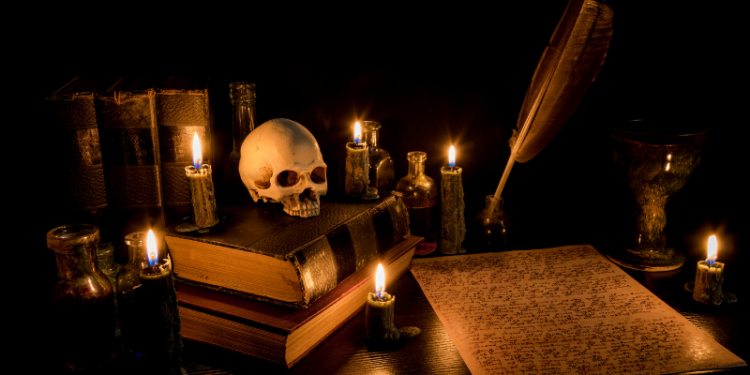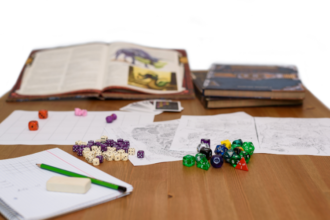How to Quickly Outline a Campaign

Running a whole campaign takes a whole lotta planning. Telling a cohesive story over multiple sessions requires a good amount of knowing where you want to take the players while allowing them to dictate the how of how they get there.
Today, we’ll take a look at a few tips on how you can sketch out a campaign outline. I generally do this kind of sketch in as broad of strokes as possible as everything will likely change once the players and their characters begin affecting the world. Think of this as less as a GPS through the story and more of a compass to point you back to the main plot when needed.
Decide what kind of campaign you’re running
The first step is to decide what kind of campaign you want to run, and what kind your players want to play. There are a ton of options here when it comes to genre. There are so many in fact, that I’ll do a whole separate article on the campaign genre.
That being said the ones that seem to be the most popular are: Heroic Fantasy, Sword and Sorcery, and Epic or Mythic Fantasy. These are all described in the Dungeon Master’s Guide starting on page 38. But, I’ll go over them briefly here and how they can relate to your campaign planning.
Heroic Fantasy is what is normally assumed by the standard Dungeons and Dragons setting. Heroes and adventurers fight monstrous threats with magical powers. Characters are generally adventurers from ordinary backgrounds, and the setting often resembles a roughly medieval era, however, the setting isn’t necessarily European.
Sword and Sorcery is more gritty with the protagonists motivate more by greed and personal gain and glory than helping other people. There tends to be slightly less magic, or magic is something that is more often used by antagonists, and the heroes overcome them through superior strength, wit, and guile.
Magic is often rare, dangerous, and shrouded in mystery. Stories like Conan the Barbarian and other classic pulp fantasy tales are in this vein.
Epic or Mythic Fantasy is more along the lines of The Lord of the Rings, and emphasized the struggle of good versus evil, with moral choices being at the core of the conflict. Evil is tangible and can be fought and defeated, and good and virtuous people exist and fight against it.
Mythic fantasy is centered around the interactions of gods and mortals, with gods interacting with and interfering with mortals. This pulls from myths from our world for inspiration.
Choosing one of these genres isn’t really necessary off the bat, but using them as a tool to help shape the general themes of your campaign can help you when you’re looking to expand the campaign in one direction or another.
Next, and slightly more importantly, you want to choose if your campaign is going to be a serial campaign, where each session is connected to and motivated by the one before it, or episodic, in which each session is a new adventure not necessarily connected to those that came before.
There are advantages to both and something I always consider is how often my group will meet. Long gaps between sessions mean it’s harder to sustain a narrative over time. A serial game might better for those kinds of games.
Guestimate the sessions & determine the main story beats
Next, I decide what the main story beats I want to hit to shape the overall arch of the campaign. There are generally four beats I want to hit over a campaign: Call to Action, First Victory, Setback, Climax. These are borrowed from storytelling methods and roughly taken from the Hero’s Journey by Joseph Cambell. Check him out, he is a great source of mythology and thinking about the story.
The Call to Action happens when the heroes first get the hook into the adventure. Whether that is the town being attacked by zombies, or a full-on sahuagin invasion, it’s the thing that kicks off the adventure, calls the heroes from their ordinary lives into the extraordinary world of adventure.
The First Victory is where the players get the upper hand on the villain, maybe defeating their strongest champion, or solving the riddle to close their tomb. This beat should push the players forward, emboldened by their victory, to strike deeper at the heart of darkness. After all, you got to give them something nice before:
The Setback. Here you get to destroy what the love and hold dear to prove that the villain is no longer playing with kiddie gloves and means business. The Setback can take the form of their base being burned down, or a major NPC dying, or even a player turning traitor. Setbacks set up the emotionally satisfying conclusion in the Climax
The Climax is the showdown with the villain or the final moral choice that decides the fate of the universe. Whatever happens here will go down in song and history. This is where the heroes either make it or break it. Both are fun outcomes! If the villain wins, the next group of heroes might be the ones to return the world back to normal.
Allow for player quests & player choice
Now within these beats allow for sessions that explore important parts of player backgrounds. These can serve as good changes of pace. A game focused more on diplomacy and role-play can change up the pace after a combat-heavy session.
And if players don’t go for your quest, don’t railroad them. Railroading is where the DM dictates what a player character does, essentially pushing them toward the adventure they’ve made.
This often creates a very boring session. It can happen too when the DM nerfs, or discounts player rolls or plans, by metagaming. The game is not DMs VS Players, it’s the Group (DM included) vs the Scenario. It doesn’t matter how events play out as long as it’s fun.
That said, if players are going into the unknown and unplanned territory, let them know and ask that they stick to what you’ve planned. If they find it boring, take their feedback and improve on your game. Friends help friends by being honest.



